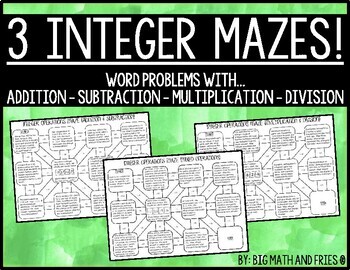Integer Operations Word Problems Maze Activities 6.3D (3 Mazes)
Big Math and Fries
108 Followers
Grade Levels
5th - 8th
Subjects
Resource Type
Standards
CCSS7.NS.A.1a
CCSS7.NS.A.1b
CCSS7.NS.A.1c
CCSS7.NS.A.2a
CCSS7.NS.A.2b
Formats Included
- PDF
Pages
7 pages
Big Math and Fries
108 Followers
What educators are saying
I really enjoyed the complexity of this assignment. It causes students to think and apply their understanding of integers in a different way!
This was a fun way for my students to show what they know on integer operations! Thank you for this fun resource!
Description
Mazes are a great way to practice new material while having more fun than completing a typical worksheet! On each of these maze activities, students will solve real-world word problems involving adding, subtracting, multiplying, and dividing integers.
Puzzle 1: Addition and Subtraction only
Puzzle 2: Multiplication and Division only
Puzzle 3: All Operations - Addition, Subtraction, Multiplication, and Division
Students will end up solving a total of 10 problems on each maze!
Answer keys to ALL puzzles are included.
Total Pages
7 pages
Answer Key
Included
Teaching Duration
N/A
Report this resource to TPT
Reported resources will be reviewed by our team. Report this resource to let us know if this resource violates TPT’s content guidelines.
Standards
to see state-specific standards (only available in the US).
CCSS7.NS.A.1a
Describe situations in which opposite quantities combine to make 0. For example, a hydrogen atom has 0 charge because its two constituents are oppositely charged.
CCSS7.NS.A.1b
Understand 𝘱 + 𝘲 as the number located a distance |𝘲| from 𝘱, in the positive or negative direction depending on whether 𝘲 is positive or negative. Show that a number and its opposite have a sum of 0 (are additive inverses). Interpret sums of rational numbers by describing real-world contexts.
CCSS7.NS.A.1c
Understand subtraction of rational numbers as adding the additive inverse, 𝘱 – 𝘲 = 𝘱 + (–𝘲). Show that the distance between two rational numbers on the number line is the absolute value of their difference, and apply this principle in real-world contexts.
CCSS7.NS.A.2a
Understand that multiplication is extended from fractions to rational numbers by requiring that operations continue to satisfy the properties of operations, particularly the distributive property, leading to products such as (–1)(–1) = 1 and the rules for multiplying signed numbers. Interpret products of rational numbers by describing real-world contexts.
CCSS7.NS.A.2b
Understand that integers can be divided, provided that the divisor is not zero, and every quotient of integers (with non-zero divisor) is a rational number. If 𝘱 and 𝘲 are integers, then –(𝘱/𝘲) = (–𝘱)/𝘲 = 𝘱/(–𝘲). Interpret quotients of rational numbers by describing real-world contexts.





